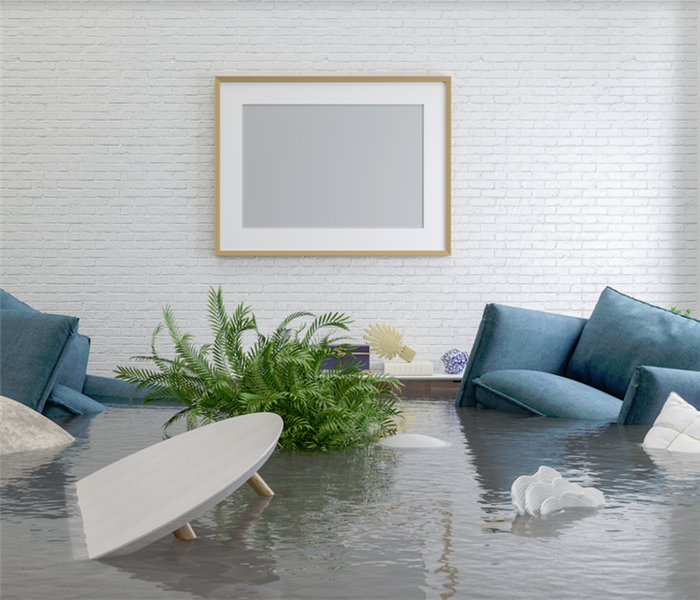Can the Floors of my Amherst Home Be Saved After Flooding?
10/18/2020 (Permalink)
 When you respond quickly, team SERVPRO can remove the water to save your floors. Contact us right away.
When you respond quickly, team SERVPRO can remove the water to save your floors. Contact us right away.
SERVPRO is a Flood Damage Specialist that Can Help Assess and Restore your Amherst Home After an Emergency.
Are floors susceptible to water damage?
Finished floors in your Amherst home are among the most susceptible to water-related damages in a flood situation. It is essential to have a professional technician inspect the finish of your floor and any other aspects of the material assembly when performing a restoration. Since floor finishes can vary significantly from carpets to hardwoods and vinyl, it is vital that you have good knowledge of how floors are constructed and what are the best methods for drying or cleaning a particular material. Our technicians have significant experience working within residential properties and can effectively apply our drying systems to different materials.
Do floodwaters have a worse effect on carpets or wood?
The type of flood damage that is sustained in your Amherst home can depend on the material. Carpeting is among the most commonly used floor finishes in residential properties. Carpets can be made from nylon, polyester, or wool, with nylon being the most resilient material. Wooden floors are repairable in almost all flooding situations, providing restoration technicians are dealing with hardwood. Lighter constructions such as vinyl are typically inexpensive, which makes replacing them a good option when considering flood repair.
What methods are used to dry wet carpets?
- In-place drying involves drying the material without disengaging the carpet and can be time-efficient especially in areas with heavy furnishings.
- Drying the carpet flat is when restoration technicians remove both the carpet and dispose of the padding before leaving it to dry on the subfloor.
- Floating a carpet involves disengaging a carpet and ventilating warm air on the underside to dry out both the laminate and the pad. An axial air-mover is ideal equipment for floating carpets.
What are carpet pads?
Carpet padding is usually a rubber or sponge material placed directly beneath the carpet and directly above the subfloor. The general thickness, or gauge, of the carpet pad, can vary from home to home. When water enters a property, it can migrate through carpet fibers and laminate, which causes the carpet pad to absorb moisture. Generally, when this moisture absorption occurs, the most effective solution is to remove the pad altogether. SERVPRO technicians can remove the pad, cut it into smaller pieces, and place in double-sealed waste bags to remove the property. In many situations replacing the carpet the pad is unnecessary as existing carpet can be rolled onto a new pad.
How does water affect floor assembly?
- Light exposure to moisture affects the finish- either carpet or floorboard solely.
- Moderate water exposure may soak into the carpet pad below the floor which can lead to microbial growth or odor.
- Significant water intrusion can affect the subfloor beneath the finish and pad requiring replacement or cavity drying.
Are hardwood floors ruined after flooding?
Properties with hardwood floors have a strong chance of restoration due to the resilience of materials like maple, oak, and birch. Often, these floorboards contain a water-resistant finish, which only wears over excess exposure to moisture. A hardwood floor is typically attached to the subfloor with vapor barriers in between to prevent condensation damages. SERVPRO can inspect these floors using a non-penetrating moisture meter to read water migration in the property accurately. Due to hardwoods' expensive nature, it is often better to restore them from even category three water damages. The steps to restore hardwood involve drying, cleaning, sanding, and then refinishing and can take several months to complete.
How can I prevent permanent damages to hardwoods after a flooding event?
When mitigating flood losses in an Amherst property, it makes sense to prioritize expensive materials. Water extraction takes place right away, and technicians may remove any coverings like carpet to save the wood. To prevent permanent damage, it is crucial to reduce the indoor humidity levels around the wood floors. The ideal humidity ratio for drying these floors is 35 to 40 grains per pound (GPP.) A desiccant dehumidifier that utilizes a silica gel can reduce indoor humidity and sustain it to the 35GPP required to save the floor. SERVPRO technicians stock both refrigerant and desiccant dehumidifiers for residential water issues.
How do professionals increase drying efficiency for wet flooring?
- Pull air from the surface by using negative air-pressure or a drying mat system.
- Push air beneath planks by positioning air-movers (this technique works best with mill grooved or sleeper system floors)
- Creating a drying tent and directing hot, dry air directly into the affected portion of the floor
Water frequently causes damage to floor assemblies in residential flooding situations. Contact SERVPRO of Merrimack at (603) 262-9293.






 24/7 Emergency Service
24/7 Emergency Service